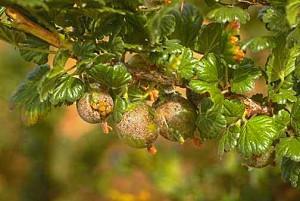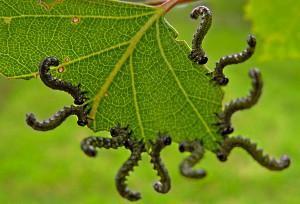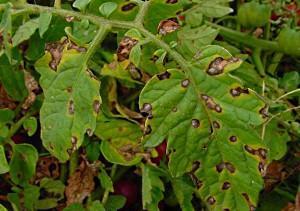Gooseberry diseases and their treatment
 Like other plants, gooseberries can be affected by insect pests. There are also various gooseberry diseases. It is very important to react in time to any of their manifestations and prevent negative effects on plants.
Like other plants, gooseberries can be affected by insect pests. There are also various gooseberry diseases. It is very important to react in time to any of their manifestations and prevent negative effects on plants.
It is important to control the condition of the plant throughout its life. If diseases or insects appear on it, medical measures should be taken immediately. If you ignore these negative factors, you can lose the crop, and in the future, the bush itself. Gooseberry diseases are spreading rapidly as they are all fungal in nature.

There are situations when the influence of insects is intertwined with the presence of diseases. You need to save the bush immediately. Gooseberry diseases and their treatment must be identified as a matter of priority.
Read the article: the benefits and harms of gooseberries!
The main diseases of the gooseberry are:
 Septoria. The disease is characterized by the rapid spread of spots on the leaves of the plant. The most dangerous period for infection is the beginning of June. At the beginning of the development of the disease, signs of gray spots with a dark brown border appear. With further development, black dots appear on the spots. This course of the disease causes premature drying out and foliage falling off. Even after falling off, the fungi continue to live in the fallen leaves. Therefore, they must be immediately removed and burned. You can look at the photo of gooseberry disease.
Septoria. The disease is characterized by the rapid spread of spots on the leaves of the plant. The most dangerous period for infection is the beginning of June. At the beginning of the development of the disease, signs of gray spots with a dark brown border appear. With further development, black dots appear on the spots. This course of the disease causes premature drying out and foliage falling off. Even after falling off, the fungi continue to live in the fallen leaves. Therefore, they must be immediately removed and burned. You can look at the photo of gooseberry disease. Spheroteka (powdery mildew). This is one of the most dangerous diseases for a plant. Its insidiousness lies in the fact that it affects not individual organs, but the entire plant as a whole. The favorable period for the development of the disease is late spring - early summer. The first signs of the development of the disease appear from the bottom of the leaves in the form of a small white coating. Over time, if the disease is not treated, it develops into a more advanced phase, which is characterized by the appearance of brown, rough seals. With the onset of such a phase, it is very difficult to save the plant. In addition, it is not recommended to leave it in this form, since spores are easily spread by insects and wind.
Spheroteka (powdery mildew). This is one of the most dangerous diseases for a plant. Its insidiousness lies in the fact that it affects not individual organs, but the entire plant as a whole. The favorable period for the development of the disease is late spring - early summer. The first signs of the development of the disease appear from the bottom of the leaves in the form of a small white coating. Over time, if the disease is not treated, it develops into a more advanced phase, which is characterized by the appearance of brown, rough seals. With the onset of such a phase, it is very difficult to save the plant. In addition, it is not recommended to leave it in this form, since spores are easily spread by insects and wind. Rust is columnar or goblet. It is a plant leaf disease. It progresses in late May - early June. Such a gooseberry disease is manifested by external symptoms - the appearance of yellow spores in the form of irregular spots. With the development of the disease, the sites of infection turn into the shape of glasses on the foliage. The disease can affect the growth and deformation of fruits, as a result of which they can fall off while still green. If you do not start treatment, you can lose the entire crop.
Rust is columnar or goblet. It is a plant leaf disease. It progresses in late May - early June. Such a gooseberry disease is manifested by external symptoms - the appearance of yellow spores in the form of irregular spots. With the development of the disease, the sites of infection turn into the shape of glasses on the foliage. The disease can affect the growth and deformation of fruits, as a result of which they can fall off while still green. If you do not start treatment, you can lose the entire crop. Anthracnose. It is also a disease that manifests itself on the leaves of the plant. Affecting areas of foliage, the disease provokes their rapid fall. It appears as dark brown spots. In the later stages of the disease, the leaves become covered with a rough, dry brown crust. If timely treatment is not started, the foliage will fall off and the plant will stop growing.
Anthracnose. It is also a disease that manifests itself on the leaves of the plant. Affecting areas of foliage, the disease provokes their rapid fall. It appears as dark brown spots. In the later stages of the disease, the leaves become covered with a rough, dry brown crust. If timely treatment is not started, the foliage will fall off and the plant will stop growing.
The presence of gooseberry diseases is not the only danger in their growth and development. There are also insects - gooseberry pests that can spoil the entire crop. They have a detrimental effect on foliage, root system and fruits.
 Pale gooseberry sawfly... These are small insects in the form of green larvae. Adults reach 6 cm in size, are dark in color with light spots. They can cause irreparable harm to the plant. Sawfly larvae develop very quickly. They are able to destroy the entire bush in one or two days. After their harmful influence, only a sinewy structure remains from the leaves, the entire surface of the leaf is destroyed and the plant stops growing.
Pale gooseberry sawfly... These are small insects in the form of green larvae. Adults reach 6 cm in size, are dark in color with light spots. They can cause irreparable harm to the plant. Sawfly larvae develop very quickly. They are able to destroy the entire bush in one or two days. After their harmful influence, only a sinewy structure remains from the leaves, the entire surface of the leaf is destroyed and the plant stops growing.
 Gooseberry sawfly yellow... The larva is bluish-green in color. Her body is covered with small warts. Adults are red-yellow in color. It is they who do great harm, nibbling the leaves entirely. If this pest is found, action must be taken.
Gooseberry sawfly yellow... The larva is bluish-green in color. Her body is covered with small warts. Adults are red-yellow in color. It is they who do great harm, nibbling the leaves entirely. If this pest is found, action must be taken.
Gooseberry Pest Control:
- Initially, you need to spray the plant with tinctures based on bitter wormwood, yarrow, tobacco or makhorka.
- A solution of soap and wood ash is also an effective means of killing larvae. You need to use it about 0.5 kg / bush.
- The use of insecticides gives a good effect.
In autumn, after harvesting, you need to loosen the soil around the bush. You can use a pitchfork. It is necessary to dig it to a depth of at least 10 cm. This will destroy all insects that hid for the winter.
 Gooseberry moth. The first sign of the presence of an insect in a plant is fruits and brushes entangled in a cobweb. In flowers, eggs are laid by adults, from which a caterpillar of bright green color with a black head hatches. In this case, the fruits are infected even at the stage of growth and formation, and never matured. They start to rot and dry out.
Gooseberry moth. The first sign of the presence of an insect in a plant is fruits and brushes entangled in a cobweb. In flowers, eggs are laid by adults, from which a caterpillar of bright green color with a black head hatches. In this case, the fruits are infected even at the stage of growth and formation, and never matured. They start to rot and dry out.
To prevent these adverse circumstances, you must:
- To destroy insect cocoons, you need to carefully dig up the soil in the fall.
- Peat or compost (mulching) should be added under the bush.
- In late autumn, gooseberries need to be hilled.
- During flowering, it is necessary to spray the gooseberry with extracts of tobacco, onions, tansy, mustard, wood ash. The same measures are repeated two more times with an interval of 14 days.
- After the flowering process, at the stage of fruit formation, you need to treat the gooseberry with lepidocide or bitoxibacillin.
If signs of cobweb entanglement are found, it is necessary to remove these parts of the plant and destroy.
 Willow shield... This harmful insect is found in most cases in areas with cold climates. Insect shields are like a spray of lime mortar. Under the veil of these formations are females and eggs of red-violet color. For the winter, the larvae die off, and come to life at the time of the gooseberry flowering. They feed from the sap of the plant through a long proboscis.
Willow shield... This harmful insect is found in most cases in areas with cold climates. Insect shields are like a spray of lime mortar. Under the veil of these formations are females and eggs of red-violet color. For the winter, the larvae die off, and come to life at the time of the gooseberry flowering. They feed from the sap of the plant through a long proboscis.
To get rid of this parasite, you must:
- Cut off heavily damaged shoots with their further destruction (you can burn).
- Whitewash the bark of the bush with slaked lime in early spring.
- After the gooseberry flowering period, you need to spray the bush with a copper-soap composition.
- With a brush, you need to clean the bark of the branches from the larvae.
 Escaping gooseberry aphid... They appear mainly on young shoots. They look like small green, black and gray bugs, which abundantly stick to the branch, destroying the plant. The shoots, under the influence of parasitic creatures, are deformed, and the leaves become twisted and dull.
Escaping gooseberry aphid... They appear mainly on young shoots. They look like small green, black and gray bugs, which abundantly stick to the branch, destroying the plant. The shoots, under the influence of parasitic creatures, are deformed, and the leaves become twisted and dull.
The main means of fighting aphids is a solution of laundry soap, water and soda ash. The proportions should be maintained as follows: for 10 liters of water, 0.7% soda ash and about 40 grams of laundry soap are needed. Apply the solution by watering or abundantly spraying the plant.
The most reliable preparations for spraying gooseberry plants are "Iskra", "Fitoverm", "Karbofos".
Diseases and pests of gooseberries are manifested mainly at the time of active growth and development of gooseberries. The gardener needs to be very careful during this period (early spring and the turn of May / June).
How to deal with gooseberry diseases?
Diseases of the gooseberry need to be treated quickly, otherwise the bush can be completely lost, and all the efforts made to grow it will be in vain. How to deal with gooseberry diseases?
In case of detection of the first signs of the disease, the following substances must be used:

- Copper and iron oxychloride, as well as Bordeaux liquid. As a result of spraying the gooseberry, the symptoms of the disease are dulled, and the disease itself recedes.
- To combat septoria, you need to use manganese sulfate, zinc and boron. These substances increase resistance to disease.
 To cure gooseberries from anthracnose, it is necessary at the first sign of it to treat the leaves with a solution of copper sulfate. It can be prepared from 10 liters of water and 40 grams of the substance. It is better to cut off heavily affected leaves.
To cure gooseberries from anthracnose, it is necessary at the first sign of it to treat the leaves with a solution of copper sulfate. It can be prepared from 10 liters of water and 40 grams of the substance. It is better to cut off heavily affected leaves. You can defeat goblet rust with Bordeaux liquid. It is necessary to process the leaves once before bud break, then after 8-10 days a second time.
You can defeat goblet rust with Bordeaux liquid. It is necessary to process the leaves once before bud break, then after 8-10 days a second time.- To get rid of powdery mildew, you need to add solutions of boron, zinc, manganese sulfate and copper to the soil around the bush.
Diseases of the gooseberry in pictures can be seen in the previous section of the article.
Video: protecting gooseberries from aphids and currant moths
How to grow a healthy gooseberry (fighting aphids, powdery mildew, etc.) video